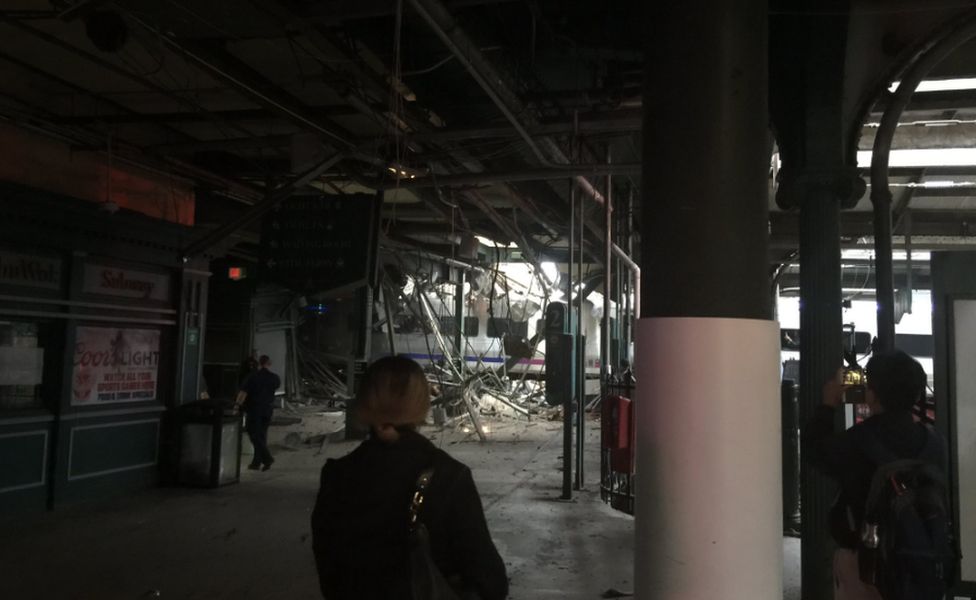Hoboken train station crash: One dead and dozens hurt in New Jersey
- Published

A woman has been killed and 108 other people injured, some of them critically, after a commuter train crashed into a railway station in the US state of New Jersey.
The train reportedly went through ticket barriers and into the reception area of Hoboken station.
Images show extensive damage to the train carriages and station, with part of the building roof caved in.
Witnesses described a scene of horror at the station.
A huge emergency services operation swung into action following the crash, with firefighters and transport staff helping people from wrecked carriages.
Hoboken is across the Hudson River from New York City. Many commuters use the busy station to travel into Manhattan.
New Jersey Governor Chris Christie confirmed there had been one fatality. She has been identified as Hoboken resident Fabiola Bittar de Kroon, aged 34.
Mr Christie said she was struck by debris while standing on a platform.
Governor Christie said the train's driver - later identified as Thomas Gallagher, aged 48 - was in serious condition and being treated at a local hospital but was co-operating with investigators.
"We have no indication that this is anything but a tragic accident," he added.
Passengers and eyewitness describe the moment the train crashed
Mark Cardona was on the platform at the time.
The "runaway" train missed me by 10-15 feet (3-5m), he told the BBC. There was "absolutely zero chance to react", Mr Cardona said.
"It went full speed into and then through the building.
"I froze. People were screaming... The ceiling started to collapse. I ran for my life."
Ben Fairclough, a witness who was at the station, told the BBC: "I wasn't on the train, but I arrived just after it happened. There was water coming down off the roof and people climbing out through the windows.
"There were people sitting down with blood coming from their head. There were lots of injuries."
NJT employee: Train "came in so quickly"
US rail safety
In 2008 the US Congress passed a law requiring all trains to install Positive Train Control (PTC) systems by the end of 2015.
But most rail companies were unable to meet the deadline as the system is expensive and complex to install. Some rail lines - including New Jersey Transit - threatened to shut down completely if it was enforced. In response, Congress extended the deadline to install PTC systems to 2018.
Rail lines can then apply for an additional two-year extension to finalise updates and test the system. But safety targets for New Jersey's commuter trains say PTC installation should be completed by 2018.
According New Jersey Transit's most recent PTC progress report, none of the 440 trains on the New Jersey Transit rail line are equipped with PTC, nor have any employees been trained on the equipment.
A 45-second look at how Positive Train Control works
PTC safety systems are designed to automatically override the actions of train engineers if the locomotive is travelling too fast. In effect, they act as a safeguard against "human error" which could cause derailments or collisions.
The system uses wifi, GPS and a specific coding system to relay real-time information from trains to control centres.
Last year, the Guardian reported that US trains were far behind those in Europe, which have had automatic safety systems for years.
Governor Christie said officials had no estimate on when the NJ Transit section of the Hoboken Terminal would re-open.
The structural integrity of the part of the building used for PATH commuter trains has been deemed safe and was expected to resume service later on Thursday.
The National Transportation Safety Board (NTSB) vice chairman, Bella Dinh-Zarr, said the agency would be looking into whether there were any similarities between Thursday's crash and one at the same station in 2011 that injured 34 people.
An NTSB investigation found excessive speed to be the main cause of the 2011 accident.
History of recent deadly passenger train crashes in US
While the US sees its fair share of deadly freight train crashes and derailments, this is the first deadly passenger train crash for five months.
- April 2016; Chester, Pennsylvania: two die and 31 injured as a train collides with a digger
- May 2015; Philadelphia, Pennsylvania: a train travelling between Washington DC and New York City derails - eight people die and 200 of the 243 people on board are injured
- February 2015; Oxnard, California: passenger train hits vehicle on the tracks - the train driver dies and 29 people are injured
- February 2015; Valhalla, New York: passenger train hits a car in suburban New York City, killing six train passengers
- Published29 September 2016
- Published29 September 2016